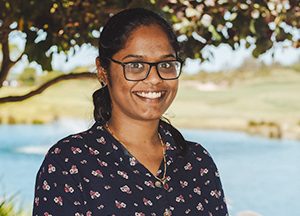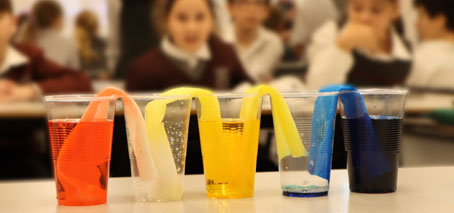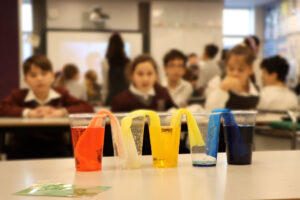Scientists finding creative ways to do science-outreach found a silver lining in COVID restrictions actually improved the experience for students, and took the scientists back to remember ignition of their own childhood ‘science spark’.
A team of FLEET PhDs and ECRs at UNSW were able to bridge 2020’s COVID restrictions to safely engage a classroom of students with virtual, but hands-on science, this month.
The team included Vivasha Govinden, Pankaj Sharma, Qi Zhang, Karina Hudson, Coco Kennedy, Matthew Rendell, Fan Ji, Cecilia Bloise and Richard Winkler.
The FLEET-led team engaged via Zoom with students from kindergarten through to Year 7 from Emanuel Primary in Sydney, running them through the background of energy use in computing, then engaging the students with some of FLEET’s home-grown homescience experiments, which the students were able to perform in class.
The event was part of the school’s first Virtual Innovation Festival.
The video developed by FLEET’s UNSW team explained the background issue of energy consumed in computing and summarised scientific efforts at FLEET to solve the issue.

Marbled milk experiment
Then, to really engage the students’ brains, the FLEET team then put the kids’ hands to work, stepping them through four of FLEET’s homescience experiments – a suite of experiments developed for use in the home or classroom.
- The Walking Rainbow experiment uses cups of coloured water ‘bridged’ by paper towels to create a rainbow
- The Marbled Milk experiment uses food colouring, milk and dish soap to illustrate chemical reactions with a fascinating, colourful ‘marbling’ visual effect
- The appearing coin experiment demonstrates refraction of light with a coin in a dish of water
- The switching arrow experiment also uses refraction of light, reversing the direction of a drawn arrow.
As well as explaining the science behind the experiments, the FLEET team were able to help the students over Zoom when they got stuck.
Finding a silver lining in creative approach to science outreach

Students experimenting with refractive index
Science-outreach has certainly been made more challenging this year with the lack of physical access to classrooms in response to COVID. But scientists are by nature creative, and outreach workarounds continue to be found.
In fact, the restrictions made necessary this year by COVID forced new ways of thinking and in many ways improved the outreach experience.
“I think there is a silver lining in this,” says FLEET’s Vivasha Govinden. “I really like the idea of having the kids doing the science themselves, rather than watching us do demonstrations, as it boosts their confidence, rather than leaving them as passive observers”.
By performing the experiments themselves, the students realise they can do science too.
“This outreach program made the kids realize that you don’t necessarily need sophisticated laboratory equipment to do science. With the help of simple household items such as matches and candles, you can do science yourself!
What really matters is the scientific approach to things – that critical/curious mind that asks why is the sky blue, why oil floats on water…”
Benefits for all

Scientists dialled in via Zoom to guide the student’s hands-on experiments
For the students, hearing from young, practising scientists person-to-person allows them to put themselves in that scientist’s place – “this could be me”, which has proven exceptionally effective in persuading young students to consider a career in STEM – particularly students in under-represented groups.
“The STEM professionals were so knowledgeable and passionate about these experiments and were able to relate them to our real lives so easily, said one student.”
Engaging student’s hands also puts their minds to work, and this has been proven most effective at embedding new learning.
“My favourite experiment was the walking rainbow,” said one student. “If you add another empty cup, you can create purple (my favourite colour) and it’s really cool to watch, especially if you time-lapse it and watch the video after!”
Students expressed interest in trying more of FLEET’s homescience experiments at home:
“Despite COVID-19 and all the restrictions that came with it, we still managed to put together a really incredible event. Emanuel Primary had a super colourful, scientific day and I know many of us felt very inspired by it all.” [student]
For FLEET’s own scientists, science-outreach exercises such as these allow them to develop key communication skills (it’s often been said that pitching your science to primary school students is remarkably similar to pitching to MPs!)
Sometimes, the realisation that science-outreach is fun, and personally valuable, can dawn slowly…

FLEET’s Vivasha Govinden found the outreach experience personally satisfying, taking her back to remember ignition of her own ‘science spark’
“I initially started to do outreach just to satisfy the 20 hours criterion,” says Vivasha. (FLEET requires each of its members to perform at least 20 hours’ outreach per year.)
“But little by little, I started to find meaning it. It felt rewarding to see ‘laymen’ feeling ‘wow’ about what we do. And it felt really good to to ‘go back to the roots’, to revisit my own childhood awakening of the joy of science!”
“In my experience, all of us in science have an ‘origin story’ — some childhood volcano experiment or insect box that gave us the original sparkle for science. I found that explaining basic science to kids took me right back to that time!”
“The experience also made me realise how science-outreach exercises such as this can instil a sense of humility to us—in the way we ‘serve’ in the name of science. That we are not just ‘Doctor So and So’, or ‘Professor So and So’. More importantly, we are science ambassadors. For me, there is almost a spiritual aspect to this: that in science outreach we give back to society in partial payment for what they (the Australian community) give us”.
“Perhaps this was always the reason for us to do outreach, it’s just today that I got this realisation!”


